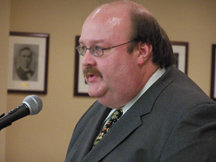For those Bayonne residents who usually start to make their morning coffee before they turn on the radio for the news, the first indication of the water main break on Route 440 in Jersey City on Jan. 4 was the sputter and rattle of pipes and a trickle of water out from the faucet.
For Bayonne – a peninsula municipality – a break like this can cripple the city, shutting off the tap water for the entire city.
This is what happened on Jan. 4 when a combination of low temperatures, shifting of the land under the surface of Route 440 and the pounding of heavy traffic resulted in a three inch tear in the 30-inch main near the entrance to the Dunkin Donuts just south of Communipaw Avenue, closing traffic in both directions as crews from Bayonne and elsewhere rushed to the site to make the repair.
“We were out there within 40 minutes to assess the situation.” – Steve Gallo
________
Steve Gallo, executive director of the BMUA, said he received the call about a break under the southbound lanes of Route 440 at about 4:30 a.m. Traffic was already affected since the break happened just south of the highway’s intersection with Communipaw Avenue, meaning that for commuters who use the highway to get to Bayonne or travel to Staten Island via the Bayonne Bridge, this was a road block. While traffic was diverted into Jersey City and eventually made its way back to Route 440 on the other side of the break, many commuters got stuck in traffic. Even traffic traveling north had to turn off the highway as crews began to assess the problem and closed the highway both ways for a while.
“The first thing we did was mobilize our staff,” Gallo said. “We were out there within 40 minutes to assess the situation. It was dangerous because the water had flowed on to the road, creating a lake of ice.”
Because the water leak created a hazardous situation, crews had to shut off the flow, and isolate the piece of pipe where the break had occurred. Turning off valves before and after the area of the break, the crews were able to isolate that area of the leak.
“By 7 a.m., we had everything shut off,” he said. “The city was without water service from about 4:30 to 7 a.m.”
By 8 a.m., water service was restored to the city, while crews worked to fix the damaged portion of the pipe. Residents, according to Joseph Ryan, city spokesperson, did not have to boil water for consumption.
Bayonne called in Joseph Jingoli & Son, Inc. in Lawrenceville, which has a contract with the city for such emergencies to excavate.
Gallo said a 12-foot section of pipe containing a three-inch tear was lifted out and replaced by another section the city had stored at its Oak Street station. Working in freezing conditions, staff placed the new section, and then connected both ends to the undamaged sections of line.
“We charged the line to check for leaks,” Gallo said. “When we found that there were no leaks, we disinfected the new section.”
This meant filling the pipe with a chorine solution, he said, which was bled off further down the pipe line before it could reach users south of the leak.
During this rapid repair, the Bayonne Fire Department with two pumper trucks containing 500 gallons of water each were on call to meet emergency water needs in the city. Gallo said the Bayonne fire chief contacted North Hudson Regional Fire Department to arrange for fire protection through the city if a fire broke out while water service was down.
Two days later on Jan. 6, a second break occurred near the ShopRite on Avenue C between 25th and 26th streets, but the repair was made without massive shut off of service.
